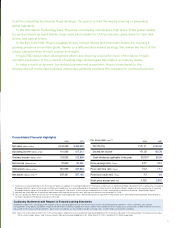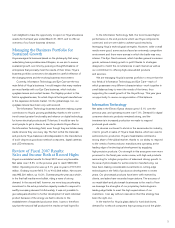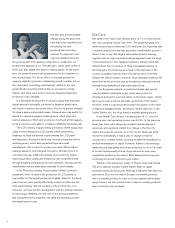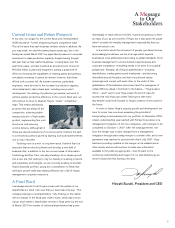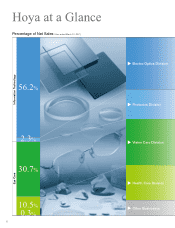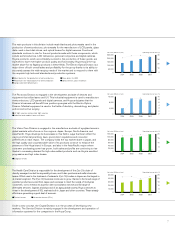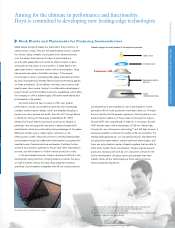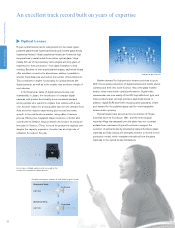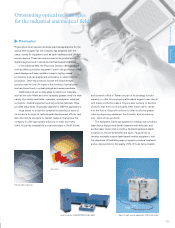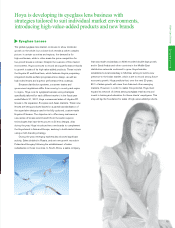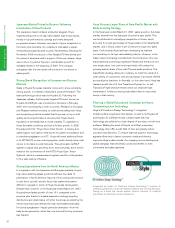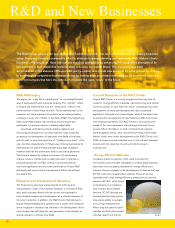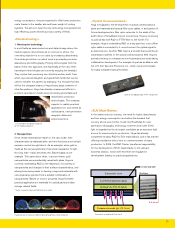Pentax 2007 Annual Report Download - page 13
Download and view the complete annual report
Please find page 13 of the 2007 Pentax annual report below. You can navigate through the pages in the report by either clicking on the pages listed below, or by using the keyword search tool below to find specific information within the annual report.
11
When data are written to an HDD, the head magnetizes the disk
as it moves across its surface, and this process allows data to be
written and read. In the conventional longitudinal recording
method, the magnetic surface of the disk was magnetized in a
horizontal direction, but with the perpendicular recording method,
the disk is magnetized in a perpendicular direction. Using the
perpendicular recording method makes it possible to write much
more data on the same surface area. Further, the neighboring
minutely sized magnetic domains exert a mutually attracting
magnetic force, and this makes it harder for recorded data to be
lost unintentionally.
Recording layer Disk magnetic layer image
S
N
S N N S S N N S
N
S
S
N
N
S
S
N
N
S
S
N
N
S
S
N
Soft magnetic layer
Glass substrate
Glass substrate
More data
can be written
Glass Memory Disks for Hard Disk DrivesElectro-Optics Division
Electro-Optics Division
Apart from their well-known use in notebook computers, hard disk
drives (HDDs) are also found in car navigation systems and portable
music players, and more recently, even in digital video cameras. The
recording media for hard disk drives used in such mobile devices has
to be able to prevent data loss, which means it must have the ability
to withstand vibration and shock. Glass memory disks have superior
shock-resistance characteristics in comparison to the aluminum
disks that are used in non-portable equipment.
The glass disks produced by Hoya can be broadly classified
into 3.0-inch, 2.5-inch and smaller diameter sizes (1.8-inch and
1.0-inch). The majority of Hoya’s disks are of the 2.5-inch size, and
these are widely used in notebook computers. Some are also
used in car navigation systems and game machines. The 3.0-inch
disks are used in servers and other high-performance computing
equipment that requires a high degree of reliability. Hoya’s smaller
diameter disks are used in portable music players and digital video
cameras, though not in great numbers.
The production of glass disks is divided into two main
processes: (1) the substrate is produced by polishing the glass
plate; and (2) the media—a magnetic recording film—is applied to
the substrate. Hoya produces disk substrates in Thailand, the
Philippines and Vietnam, and the magnetic media is applied in
Singapore. In the fiscal year ended March 31, 2007, notebook
computers shipments saw global growth, and Hoya was able to
respond to the increasing demand thanks to its recent investment
in a new plant in Vietnam and new production lines in Singapore.
The market continues to demand ever greater data recording
capacity for movies, music, and other content. This trend is driving
the continuing shift from the conventional longitudinal recording
method to the new perpendicular recording method,*1 which
enables a greater data storage volume. Hoya has already
commenced shipment of disks that use the new method, and is
working to produce media with even greater storage capacity.
As HDDs increase in storage capacity, competition among HDD
manufacturers is intensifying. With the resulting decline in HDD
prices, there is more demand for lower prices on both substrates
and media. In this environment, Hoya is taking full advantage of its
integrated HDD production capability—from raw materials to
substrate production and application of media—to deliver
high-quality products at low cost to meet the evolving needs of the
market. With a close watch on the future, Hoya is also actively
engaged in development of next-generation technologies and the
technologies that will follow the next generation, such as discrete
track recording technology*2 and bit-patterned media technology,*3
which are anticipated to increase recording capacities dramatically.
Thanks to their excellent shock resistance characteristics and
large data storage capacity, Hoya’s memory disks have become
indispensable in notebook computers
Glass Memory Disks for Hard Disk Drives
*1.
This technology increases data recording density on the HDD by magnetizing the media in a direction perpendicular to the disk’s surface, as opposed to the horizontal direction conventionally used.
*2. By making a groove between recording tracks, it is possible to reduce the magnetic interference between neighboring tracks. It is anticipated that this will make possible further
miniaturization and greater recording density.
*3. Recording media in which magnetic particles are physically isolated from each other in a regular pattern. Neighboring magnetic particles are not affected by each other, and it is
anticipated that this will make it possible to achieve much higher recording density.
How does the perpendicular recording method reduce
the size of disk drives while increasing their data
storage capacity?
Perpendicular recording methodLongitudinal recording method
(conventional method)


